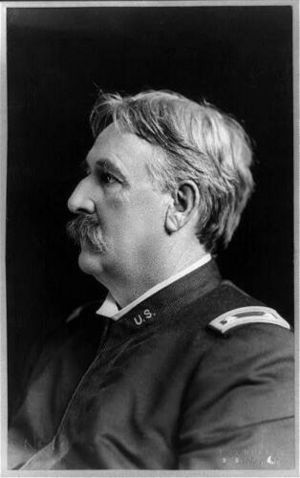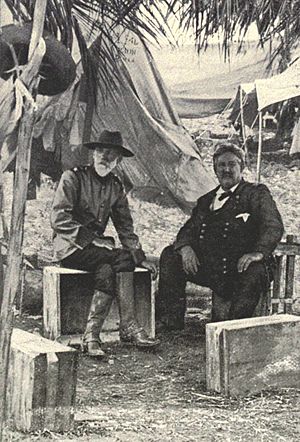William Rufus Shafter facts for kids
Quick facts for kids
William Rufus Shafter
|
|
|---|---|

Shafter in 1898
|
|
| Nickname(s) | "Pecos Bill" |
| Born | October 16, 1835 Galesburg, Michigan, U.S. |
| Died | November 12, 1906 (aged 71) Bakersfield, California, U.S. |
| Place of burial |
San Francisco National Cemetery, San Francisco, California, U.S.
|
| Allegiance | |
| Service/ |
|
| Years of service | 1861–1901 |
| Rank | |
| Unit | 7th Michigan Infantry Regiment 19th Michigan Volunteer Infantry Regiment |
| Commands held | 17th U.S. Colored Infantry Regiment 24th U.S. Infantry Regiment Fifth Army Corps Department of California |
| Battles/wars |
List
|
| Awards | Medal of Honor |
William Rufus Shafter (October 16, 1835 – November 12, 1906) was an important Union Army officer during the American Civil War. He earned the Medal of Honor, America's highest military award, for his brave actions at the Battle of Fair Oaks. Later, as a major general, he played a big part in the Spanish–American War.
Places like Fort Shafter in Hawaii and the city of Shafter, California are named after him. He was also known by the nickname "Pecos Bill," which inspired the famous fictional character in American folk tales.
Contents
Early Life and Beginnings
William Rufus Shafter was born in Galesburg, Michigan, on October 16, 1835. His family had German roots. Before the Civil War, he worked as a teacher and a farmer.
Serving in the Civil War
Shafter started his military career as a first lieutenant in the 7th Michigan Volunteer Infantry Regiment. He fought in battles like Ball's Bluff and Fair Oaks. At the Battle of Fair Oaks, he showed great bravery. He led a charge and was wounded, but he hid his injury to keep fighting with his regiment the next day. For this heroism, he later received the Medal of Honor.
After being briefly out of service, he returned as a major in the 19th Michigan Volunteer Infantry Regiment. He was captured at the Battle of Thompson's Station and spent three months as a prisoner of war. In 1864, after his release, he became a colonel and led the 17th United States Colored Infantry at the Battle of Nashville.
After the Civil War: Indian Wars
By the end of the Civil War, Shafter had been promoted to brevet brigadier general. He decided to stay in the regular army. During his service in the Indian Wars, he earned his famous nickname, "Pecos Bill."
He commanded the 24th Infantry, another regiment of United States Colored Troops. They were involved in campaigns against Native American warriors like the Cheyenne, Comanche, Kickapoo, and Kiowa in Texas. In May 1897, he was promoted to brigadier general.
The Spanish–American War
Just before the Spanish–American War began, Shafter was in charge of the Department of California. He was an unexpected choice to lead the mission to Cuba. He was nearly 63 years old, weighed over 300 pounds, and suffered from gout, a painful joint condition. Despite this, he was promoted to Major General of Volunteers. He was given command of the Fifth Army Corps, which was gathering in Tampa, Florida.
Shafter's leadership during the Cuba expedition was sometimes disorganized. The landing at Daiquiri on Cuba's southern coast was confusing. There was a lot of mix-up about what equipment to unload first and who was in charge. Shafter even had to personally step in to make sure important Gatling Guns were unloaded quickly.
Battles in Cuba
During the landing, Shafter sent the Cavalry Division, led by Joseph Wheeler, to scout the road to Santiago de Cuba. Wheeler started a fight that grew into the Battle of Las Guasimas. Shafter seemed unaware of this battle at the time and did not discuss it with Wheeler afterward.
A plan was made to attack Santiago. Shafter's forces would attack El Caney and the heights known as San Juan Hill. Shafter had planned to lead from the front. However, he became very ill from the tropical heat and had to stay at his headquarters, far from the fighting. Because he could not see the battle, he struggled to manage his troops effectively.
Shafter's battle plans were simple and not very detailed. He did not seem to fully understand the power of modern Spanish weapons. His efforts to gather information about Spanish troops and equipment were also very limited.
Challenges and Victory
During the attacks on El Caney and San Juan Heights, American soldiers faced heavy losses. They were packed onto the roads, making it hard to move. Spanish troops had modern rifles and artillery, while American guns were less effective. Despite suffering about 1,400 casualties, American troops bravely stormed and took control of El Caney and San Juan Heights.
Next, Shafter had to surround and lay siege to the city of Santiago. The large number of American casualties made Shafter doubt if they could win. He knew his troops were in a difficult spot. Supplies were not reaching his men, and he himself was very ill and weak.
Shafter sent a message to Washington suggesting the army should retreat. However, he soon changed his mind and continued the siege. The U.S. Navy's victory at the Battle of Santiago de Cuba sealed the fate of the Spanish forces. Soon after, the Spanish commander surrendered the city.
Life After the War
Many American soldiers in Cuba became sick, so Shafter and his officers wanted to leave Cuba quickly. Shafter himself left in September 1898. After a time in quarantine, he returned to serve as Commander of the Department of California until 1901.
In this role, he helped supply the army's mission to the Philippines. This mission grew into the Philippine–American War. Shafter shared his thoughts on the conflict, saying that sometimes difficult actions might be needed to help people achieve a better way of life.
Shafter was a member of several military organizations, including the Military Order of the Loyal Legion of the United States. He retired in 1901 to a farm in Bakersfield, California. He passed away there in 1906 and is buried at San Francisco National Cemetery.
Military Awards
- Medal of Honor
- Civil War Campaign Medal
- Indian Campaign Medal
- Spanish Campaign Medal
See also
 In Spanish: William Rufus Shafter para niños
In Spanish: William Rufus Shafter para niños



